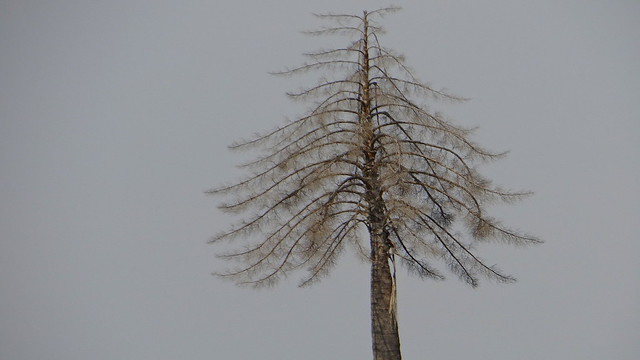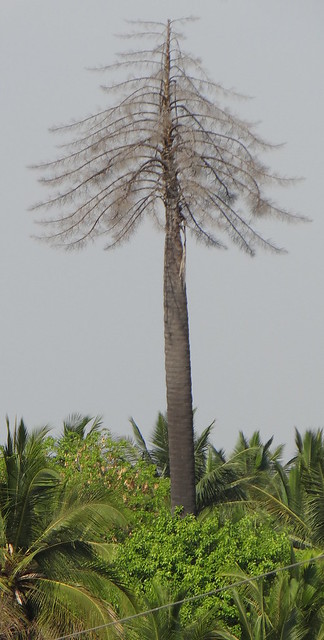A giant of a palm tree Kanakapura Pipe Road, 280114
On the way to Sundaghatta, I suddenly was struck by a truly majestic, dead tree!
This was, I learnt from Arun Kumar,
Corypha umbraculifera, the TALIPOT PALM
which is a species of palm native to eastern and southern India (Malabar Coast) and Sri Lanka.
It is one of the largest palms in the world; individual specimens have reached heights of up to 25 m (82 ft) with stems up to 1.3 m (4.25 ft) in diameter.[1] You can see its height above the coconut palm trees:
It is a fan palm (Arecaceae tribe Corypheae), with large, palmate leaves up to 5 m (16 ft) in diameter, with a petiole up to 4 m (13 ft), and up to 130 leaflets.
The talipot palm bears the largest inflorescence of any plant, 6-8 m (20-26 ft) long, consisting of one to several million small flowers borne on a branched stalk that forms at the top of the trunk (the titan arum, Amorphophallus titanum, from the family Araceae, has the largest unbranched inflorescence, and the species Rafflesia arnoldii has the world’s largest single flower).
The talipot palm is monocarpic, flowering only once, when it is 30 to 80 years old. It takes about a year for the fruit to mature, producing thousands of round, yellow-green fruit 3-4 cm (1.2-1.6 in) in diameter, each containing a single seed.
The plant dies after fruiting.
The talipot palm is cultivated throughout Southeast Asia, north to southern China. Historically, the leaves were written upon in various Southeast Asian cultures using an iron stylus to create palm leaf manuscripts. This must have been the original “olai chuvadu”!
The tree is known as kudapana in Malayalam Language, which means “umbrella” palm tree. On the Malabar Coast, the palm leaves were used to make traditional umbrellas for agricultural workers and students in rural areas until a few decades ago.
What a wonderful amount of information from one stray look at a huge dead tree!
Update: Mitalee Verma writes:
Must say you’ve been misled a bit here. Contrary to what it says on Wikipedia, this tree most certainly does not die after fruition. I should know cause I grew up with three of them in my home. One was cut down by one of my uncles sometime in 1990’s, one was accidentally burnt down, though it has since re-grown to it’s former glory, and the third is the original tree, planted by my late aunt in 1939-40. I’ve seen it bear fruit every single year since I was a child and we used to use the seeds as pellets to throw at each other. Squirrels favour the seeds immensely as do those angry-birdish looking birds which always live in groups of seven, called ‘sat bhravan’ in Punjabi. Many of our factory workers used the leaves to thatch their huts just as it says on Wikipedia. Some would cut off the outer portion of the leaves and make fans with them. They take a long time to grow and though our original tree is almost 75 years old now it’s nowhere as majestic as the specimen, albeit dead, you’ve taken a picture of! I will click a photo of the talipot tree when I visit my childhood home next, probably when Manini comes visiting (from Chicago).’ We also have a bottle palm, a decade younger than the talipot palm, reaching heights of about 15 meters.



